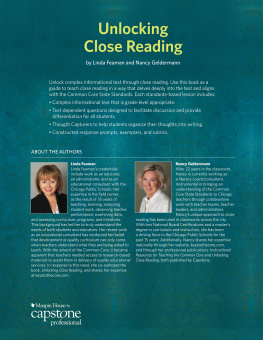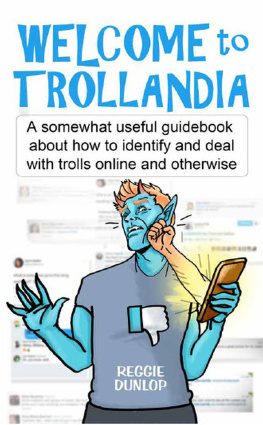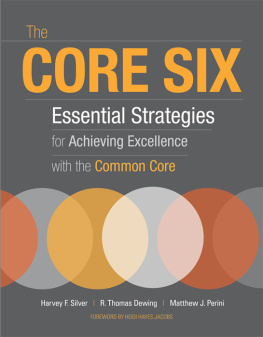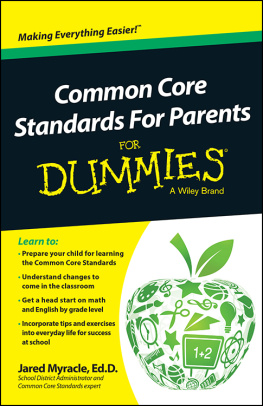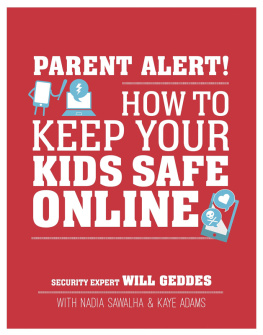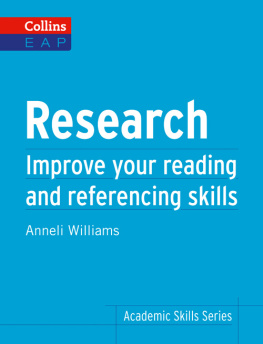Published in 2018 by The Rosen Publishing Group, Inc.
29 East 21st Street, New York, NY 10010
Copyright 2018 by The Rosen Publishing Group, Inc.
First Edition
All rights reserved. No part of this book may be reproduced in any form without permission in writing from the publisher, except by a reviewer.
Library of Congress Cataloging-in-Publication Data
Names: Adams, Sabrina, author.
Title: Everything you need to know about trolls and cybermobs / Sabrina Adams.
Description: New York : Rosen Publishing, 2018. | Series: The need to know library | Audience: Grades 712. | Includes bibliographical references and index.
Identifiers: LCCN 2017003231| ISBN 9781508174202 (librarybound) | ISBN 9781508174189 (pbk.) | ISBN 9781508174196 (6-pack)
Subjects: LCSH: CyberbullyingJuvenile literature. | Online trollingJuvenile literature. | Internet and teenagersJuvenile literature.
Classification: LCC HV6773.15.C92 A33 2018 | DDC 302.34/302854678dc23
LC record available at https://lccn.loc.gov/2017003231
Manufactured in the United States of America
CONTENTS
INTRODUCTION
CHAPTER ONE
TROLLS AND CYBERMOBS
CHAPTER TWO
HOW CAN YOU PROTECT YOURSELF AND OTHERS?
CHAPTER THREE
WHAT IF IT HAPPENS TO YOU?
CHAPTER FOUR
HEALING FROM CYBER ATTACKS
GLOSSARY
FOR MORE INFORMATION
FOR FURTHER READING
BIBLIOGRAPHY
INDEX
INTRODUCTION
e dont often think about it when we are posting on or visiting social media websites, but the internet can be a dangerous place. The online world has become a place where people behave differently than in the real world. In some cases, people become victims of harassment and bullying due to the unusually abusive nature of some internet users. These online realities have become such a problem that they spill over into the real world. Serious cases of cyberbullying and online harassment have cost people jobs, friendships, and, in some instances, even their lives.
In some cases, people have been pushed to dangerous limits as a result of being stalked online by cyberbullies. One instance includes a story from a September 19, 2014, article in Newsweek magazine about a woman who posted body-positive messages about herself. Bullies calling her stupid, fat, and ugly harassed her nonstop and even cost her the job she had at a nonprofit organization. Trolls who had never even met her posted false claims about her sexual misconduct. Then posts under her name with the heading Do Not Hire appeared, with claims that she would not make a good employee. This kept prospective employers from hiring her when they searched her name online. She committed suicide.
Protesters hold up signs of Rehtaeh Parsons to show their support for victims of cyberbullying and victimization on the internet.
Age does not seem to matter as far as cyberbullying is concerned. According to Newsweek, a seventeen-year-old named Rehtaeh Parsons killed herself after being gang-raped at a party. Someone posted the photo of the rape on the internet, causing her extreme distress. A fourteen-year-old named Jamey Rodemeyer committed suicide after experiencing harassment online for being gay. One fourteen-year-old named Jill Naber killed herself after a photo of her topless was viewed and shared to the point of becoming viral. Fatal incidences like these have only increased as the internet and social media become more and more a part of peoples everyday lives.
The internet and social media now enter peoples lives at an earlier age than ever. And the damage of internet trolling leaves a permanent footprint that the victim will not be able to shake for years to come. Thats why it is important to try to understand where this type of behavior comes from, how it affects people, what people can do to avoid it, and how people can take care of themselves if they are ever a victim of online trolls or cybermobs.
CHAPTER ONE
TROLLS AND CYBERMOBS
O ver the past decade, the damage of trolls and cybermobs has increased, and it has had a profound impact on our youth. According to an article in Time magazine, 70 percent of 18- to 24-year-olds who use the internet have experienced some form of online harassment. Unfortunately, it comes in many forms.
WHAT IT IS
Two of the most damaging forms of online harassment are trolling and cybermobs. A troll is traditionally defined as a mythical creature, or goblin, hiding in caves or under bridges. In folklore, trolls often jump out at innocent passersby, harassing them and causing trouble. In a similar way, an online troll is someone who deliberately causes trouble online, posting insulting messages or trying to cause psychological damage to people. Their methods include threatening users on social media, publishing personal information, or humiliating people because of their race, sex, or body type. Trolling can be as simple as writing Youre an idiot to as fiercely damaging as cursing at someone, putting down their efforts, or threatening them in some way. Only the more extreme examples offer cause for alarm and perhaps a more proactive reaction.
Some online trolls become part of a cybermob. Thats a group of two or more people who gang up on someone to harass or terrorize that person online. The way a cybermob forms is that an online troll with many friends or followers requests that his or her followers post negative information on someones social media account. The greater the number of people who follow the instructions, the larger the cybermob becomes, extending the reach of cybermobs quite far. Thus, cybermobs can be that much more damaging than the work of just one online troll.
CYBERMOBS: ALL KINDS OF TARGETS
Many preteens and teens are subject to online trolling and cybermobs, and even celebrities and the rich are subjected to cyberbullying. Shortly after the release of the 2016 version of the film Ghostbusters, in which Leslie Jones was a costar, people began posting racist, sexist, and overtly insensitive and insulting comments about her. She was harassed so badly on Twitter that she quit the social media site for a period of time.
The person who was caught trolling and encouraging the cybermob that harassed Jones was conservative British journalist Milo Yiannopoulos. He was permanently banned from Twitter after it was found that he encouraged his 300 thousand followers to harass Jones.
Actress and comedian Leslie Jones (pictured) was harassed online by Milo Yiannopolis. The incident brought the issue of cyberbullying into the national conversation when the media began to report on it.
Cybermobs cause damage to individuals for countless reasons, such as due to their weight, social standing, sexual orientation, or physical or mental disabilities. However, not all targets of cybermobs are individuals. An organization can also be the target of a cybermob. This can be a group of angry individuals who want to show their distaste for a late video game launch or a product that does not work to their liking. Or they may want to attack some other act that has inadvertently displeased many people. For example, in 2011, a Manhattan dentist received a negative online review of her services. When the dentist asked the patient to remove the review because she thought it contained lies, the patient sued her. From that point on, people ganged up on the dentists website, giving false reviews and saying terrible things about her. Their false claims included everything from saying she was sleeping with her patients to her having AIDS. She even started getting threatening phone calls at both her office and her home. Because she was being sued, her insurance rates were increased tremendously. Ultimately, she could no longer attract new patients or keep the old ones. Within a year, she was forced to close her dental practice.


